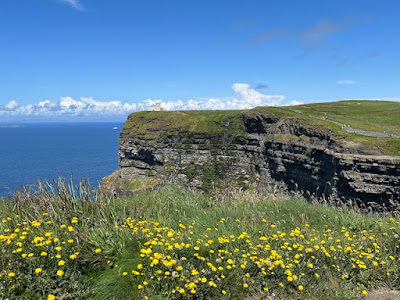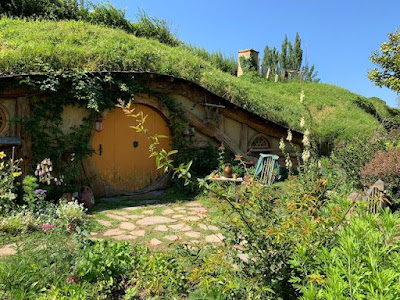The cliffs were stunning. We were here 12 years ago and they were totally fogged in, so this was an amazing experience. As you might expect there are large bird colonies that nest here, including the largest Puffin colony of over 7000 birds comes here to breed. They winter on the ocean. The baby puffins - Pufflings - jump into the water at night to avoid being picked off by the gulls and learn how to fly from the water before heading out to sea.
There is another old 'fort' building on the end of the point (far right). Its about a 5 mile hike round trip. We really wanted to do it, but realized we would not be able to make it to Dungaire Castle before it closed if we didn't leave sooner than that.
The cliffs were formed about 300 million years ago. The layers you can see include siltstone, slate and shale. The silt and mud flowed down to this area from the nearby mountains in a river which deposited the soil here in layers. The sandstone is more resistant to erosion, but can't support its own weight well, so people are advised to stand well back from the edge.
There are slate fences that line the pathway. The slate is abundant here. All the fascinating patterns are from fossils when it was formed. The stones are 6 ft tall, but about 2 feet are below the surface supporting the weight of the stone.
The largest population of birds are the Guillemot with over 60,000 nesting pairs. They lay a single egg directly on the rocky cliff. The eggs are oblong with pointier ends than a hen's egg, so if they are knocked they don't roll of the cliff, but roll in a circle. Clever, Mother Nature!
It was hard to stop taking pictures.
The wildflowers are my favorite everywhere we go!
All day long there were puffs of clouds on the horizon, but they didn't turn to rain until the end of the day.
There is a long tradition of music along the cliffs. We enjoyed several of this performers along the walk.
The visitor center for the Cliffs brought back fond memories of previous travels and hobbit holes.





















No comments:
Post a Comment